Comprehensive Project on Understanding and Managing Data Contents
VerifiedAdded on 2023/06/12
|14
|1677
|203
Project
AI Summary
This project solution provides a detailed analysis of understanding and managing data contents within a financial context. It includes computations of standard deviation, interpretation of mean and standard deviation, completion of expenditure tables, and commentary on minimum consumer spending. The project distinguishes between cross-sectional and time-series data, constructs a network diagram, identifies critical paths and project duration, and differentiates between critical and non-critical activities. Furthermore, it calculates the correlation matrix between factors and quarterly revenue, identifies the best predictor for quarterly sales, creates a scatter graph with a regression equation trend line, evaluates the coefficient of correlation and its determination, and states the regression equation. The analysis extends to computing the coefficient of variation for ventures A and B, making risk-based project selections, and reflecting on the project's learning outcomes. The project also covers break-even analysis, including variable cost anticipation, fixed cost computation, break-even point calculation, target sales achievement, margin of safety computation, and a discussion of the pros and cons of break-even analysis. This assignment solution is available on Desklib, offering students a valuable resource for understanding financial data analysis.
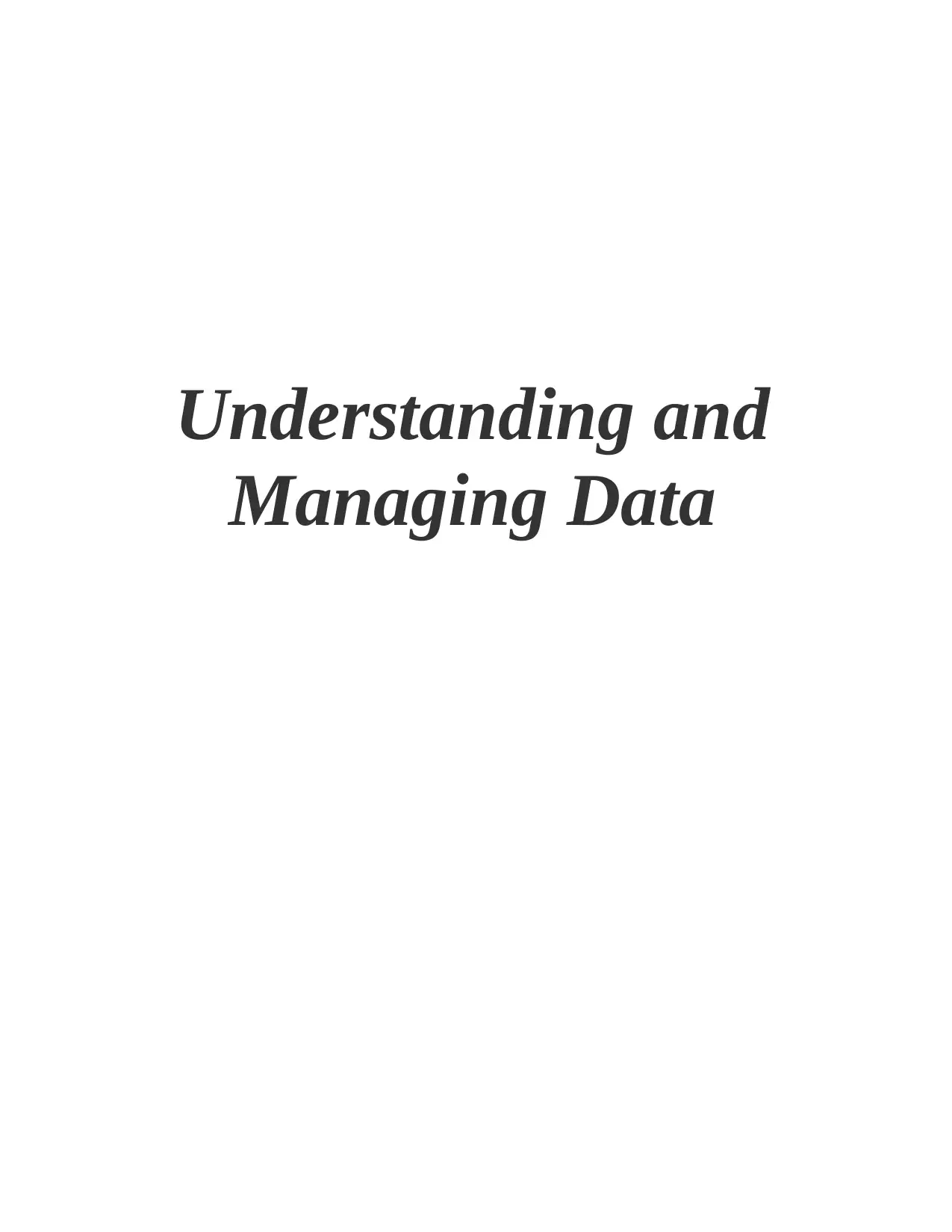
Understanding and
Managing Data
Managing Data
Paraphrase This Document
Need a fresh take? Get an instant paraphrase of this document with our AI Paraphraser

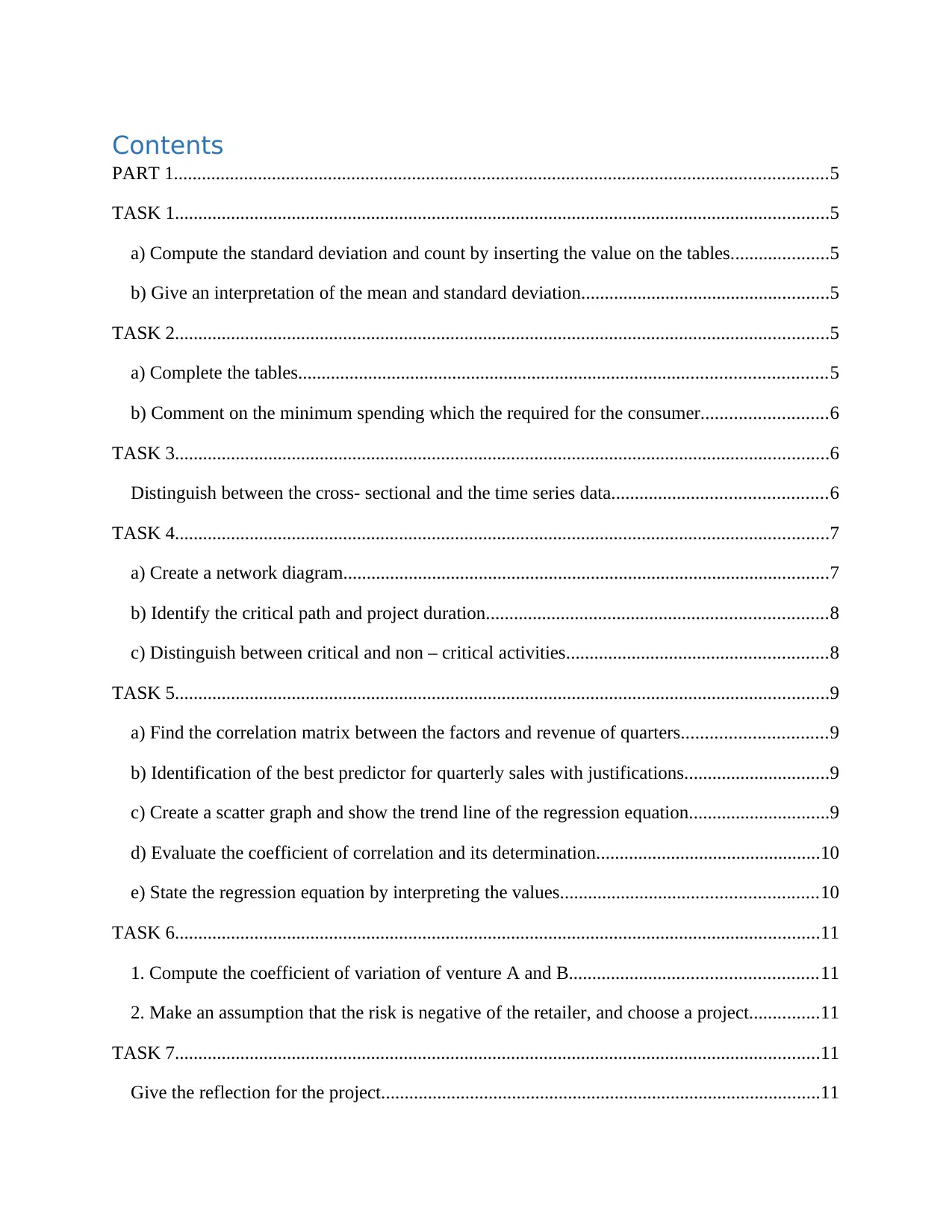
Contents
PART 1............................................................................................................................................5
TASK 1............................................................................................................................................5
a) Compute the standard deviation and count by inserting the value on the tables.....................5
b) Give an interpretation of the mean and standard deviation.....................................................5
TASK 2............................................................................................................................................5
a) Complete the tables.................................................................................................................5
b) Comment on the minimum spending which the required for the consumer...........................6
TASK 3............................................................................................................................................6
Distinguish between the cross- sectional and the time series data..............................................6
TASK 4............................................................................................................................................7
a) Create a network diagram........................................................................................................7
b) Identify the critical path and project duration.........................................................................8
c) Distinguish between critical and non – critical activities........................................................8
TASK 5............................................................................................................................................9
a) Find the correlation matrix between the factors and revenue of quarters...............................9
b) Identification of the best predictor for quarterly sales with justifications...............................9
c) Create a scatter graph and show the trend line of the regression equation..............................9
d) Evaluate the coefficient of correlation and its determination................................................10
e) State the regression equation by interpreting the values.......................................................10
TASK 6..........................................................................................................................................11
1. Compute the coefficient of variation of venture A and B.....................................................11
2. Make an assumption that the risk is negative of the retailer, and choose a project...............11
TASK 7..........................................................................................................................................11
Give the reflection for the project..............................................................................................11
PART 1............................................................................................................................................5
TASK 1............................................................................................................................................5
a) Compute the standard deviation and count by inserting the value on the tables.....................5
b) Give an interpretation of the mean and standard deviation.....................................................5
TASK 2............................................................................................................................................5
a) Complete the tables.................................................................................................................5
b) Comment on the minimum spending which the required for the consumer...........................6
TASK 3............................................................................................................................................6
Distinguish between the cross- sectional and the time series data..............................................6
TASK 4............................................................................................................................................7
a) Create a network diagram........................................................................................................7
b) Identify the critical path and project duration.........................................................................8
c) Distinguish between critical and non – critical activities........................................................8
TASK 5............................................................................................................................................9
a) Find the correlation matrix between the factors and revenue of quarters...............................9
b) Identification of the best predictor for quarterly sales with justifications...............................9
c) Create a scatter graph and show the trend line of the regression equation..............................9
d) Evaluate the coefficient of correlation and its determination................................................10
e) State the regression equation by interpreting the values.......................................................10
TASK 6..........................................................................................................................................11
1. Compute the coefficient of variation of venture A and B.....................................................11
2. Make an assumption that the risk is negative of the retailer, and choose a project...............11
TASK 7..........................................................................................................................................11
Give the reflection for the project..............................................................................................11
⊘ This is a preview!⊘
Do you want full access?
Subscribe today to unlock all pages.

Trusted by 1+ million students worldwide
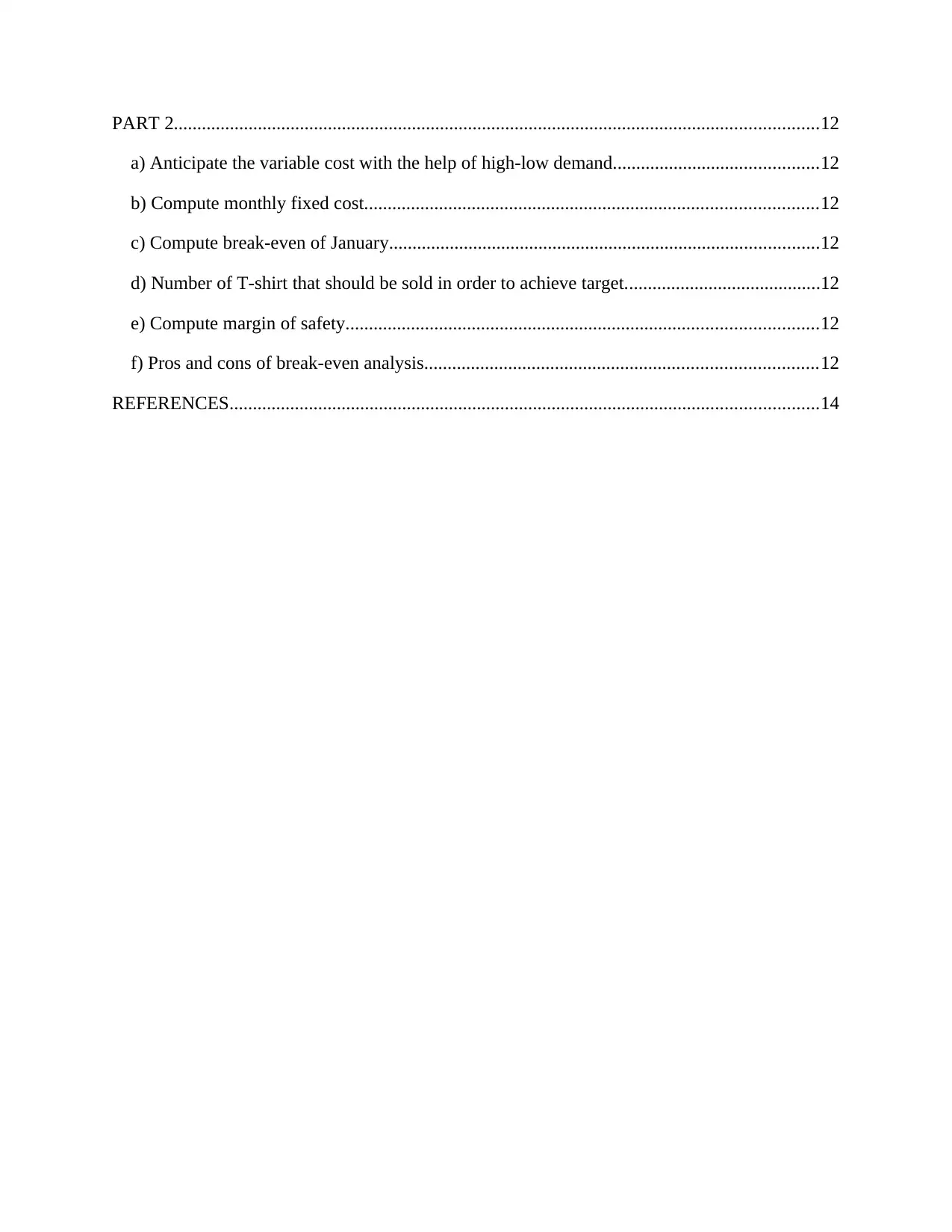
PART 2..........................................................................................................................................12
a) Anticipate the variable cost with the help of high-low demand............................................12
b) Compute monthly fixed cost.................................................................................................12
c) Compute break-even of January............................................................................................12
d) Number of T-shirt that should be sold in order to achieve target..........................................12
e) Compute margin of safety.....................................................................................................12
f) Pros and cons of break-even analysis....................................................................................12
REFERENCES..............................................................................................................................14
a) Anticipate the variable cost with the help of high-low demand............................................12
b) Compute monthly fixed cost.................................................................................................12
c) Compute break-even of January............................................................................................12
d) Number of T-shirt that should be sold in order to achieve target..........................................12
e) Compute margin of safety.....................................................................................................12
f) Pros and cons of break-even analysis....................................................................................12
REFERENCES..............................................................................................................................14
Paraphrase This Document
Need a fresh take? Get an instant paraphrase of this document with our AI Paraphraser
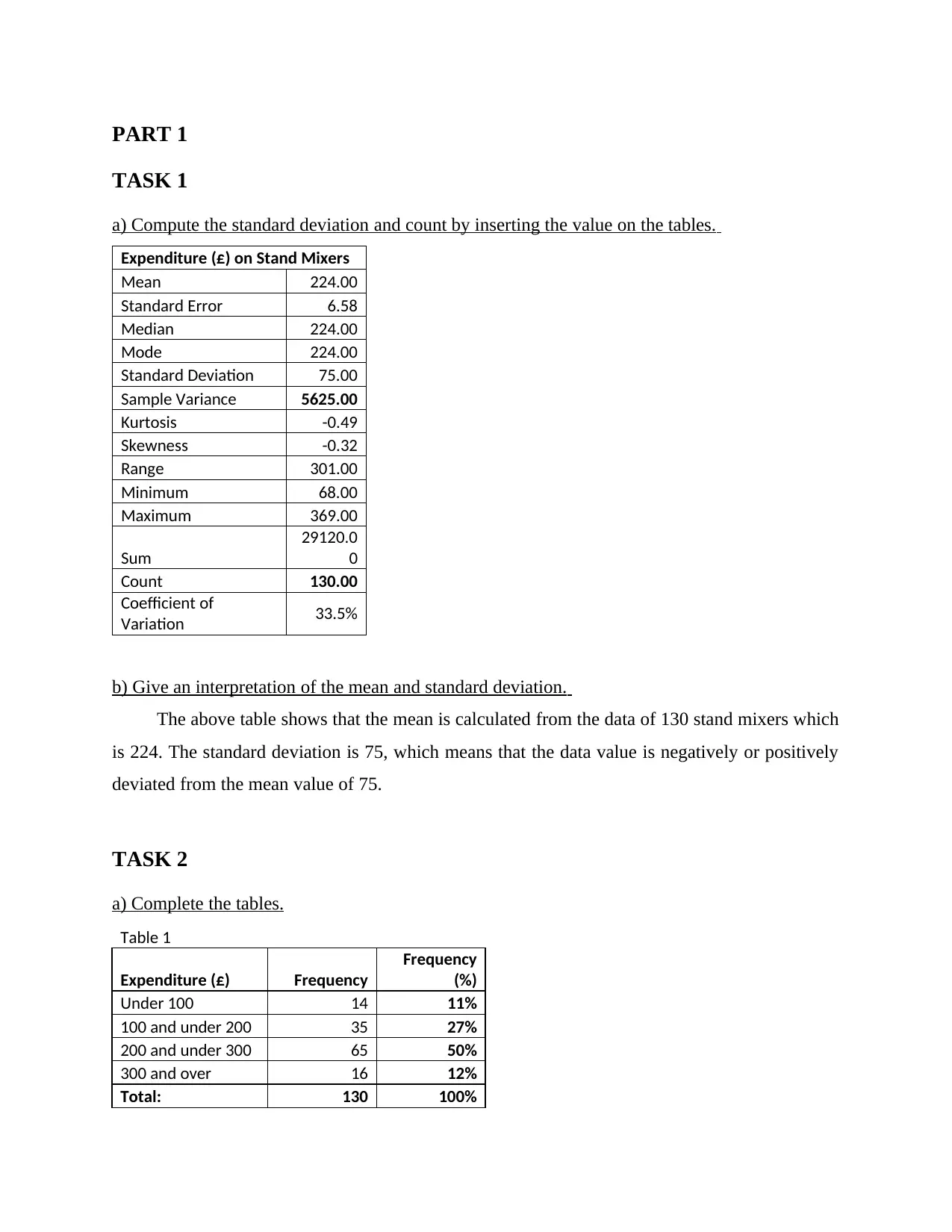
PART 1
TASK 1
a) Compute the standard deviation and count by inserting the value on the tables.
Expenditure (£) on Stand Mixers
Mean 224.00
Standard Error 6.58
Median 224.00
Mode 224.00
Standard Deviation 75.00
Sample Variance 5625.00
Kurtosis -0.49
Skewness -0.32
Range 301.00
Minimum 68.00
Maximum 369.00
Sum
29120.0
0
Count 130.00
Coefficient of
Variation 33.5%
b) Give an interpretation of the mean and standard deviation.
The above table shows that the mean is calculated from the data of 130 stand mixers which
is 224. The standard deviation is 75, which means that the data value is negatively or positively
deviated from the mean value of 75.
TASK 2
a) Complete the tables.
Table 1
Expenditure (£) Frequency
Frequency
(%)
Under 100 14 11%
100 and under 200 35 27%
200 and under 300 65 50%
300 and over 16 12%
Total: 130 100%
TASK 1
a) Compute the standard deviation and count by inserting the value on the tables.
Expenditure (£) on Stand Mixers
Mean 224.00
Standard Error 6.58
Median 224.00
Mode 224.00
Standard Deviation 75.00
Sample Variance 5625.00
Kurtosis -0.49
Skewness -0.32
Range 301.00
Minimum 68.00
Maximum 369.00
Sum
29120.0
0
Count 130.00
Coefficient of
Variation 33.5%
b) Give an interpretation of the mean and standard deviation.
The above table shows that the mean is calculated from the data of 130 stand mixers which
is 224. The standard deviation is 75, which means that the data value is negatively or positively
deviated from the mean value of 75.
TASK 2
a) Complete the tables.
Table 1
Expenditure (£) Frequency
Frequency
(%)
Under 100 14 11%
100 and under 200 35 27%
200 and under 300 65 50%
300 and over 16 12%
Total: 130 100%
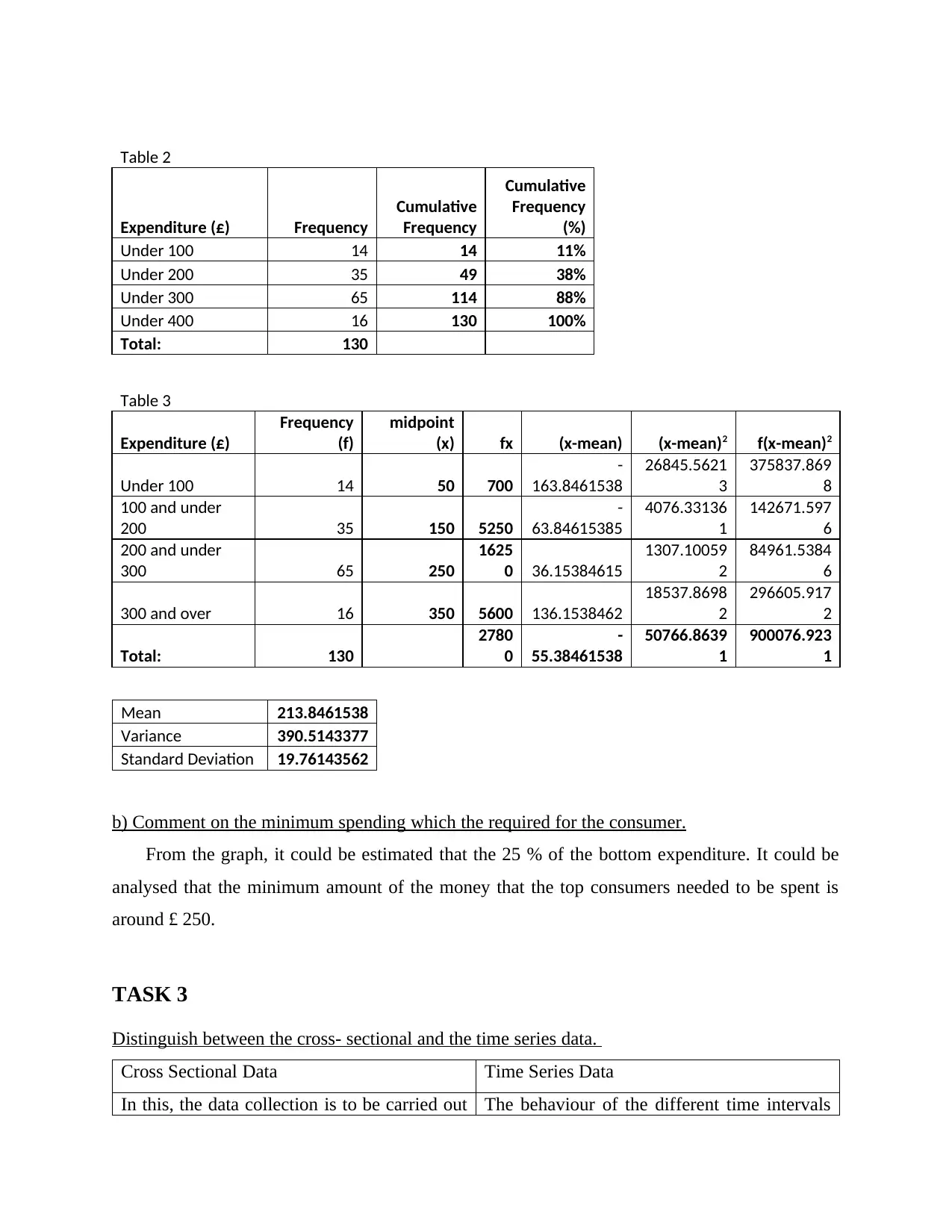
Table 2
Expenditure (£) Frequency
Cumulative
Frequency
Cumulative
Frequency
(%)
Under 100 14 14 11%
Under 200 35 49 38%
Under 300 65 114 88%
Under 400 16 130 100%
Total: 130
Table 3
Expenditure (£)
Frequency
(f)
midpoint
(x) fx (x-mean) (x-mean)2 f(x-mean)2
Under 100 14 50 700
-
163.8461538
26845.5621
3
375837.869
8
100 and under
200 35 150 5250
-
63.84615385
4076.33136
1
142671.597
6
200 and under
300 65 250
1625
0 36.15384615
1307.10059
2
84961.5384
6
300 and over 16 350 5600 136.1538462
18537.8698
2
296605.917
2
Total: 130
2780
0
-
55.38461538
50766.8639
1
900076.923
1
Mean 213.8461538
Variance 390.5143377
Standard Deviation 19.76143562
b) Comment on the minimum spending which the required for the consumer.
From the graph, it could be estimated that the 25 % of the bottom expenditure. It could be
analysed that the minimum amount of the money that the top consumers needed to be spent is
around £ 250.
TASK 3
Distinguish between the cross- sectional and the time series data.
Cross Sectional Data Time Series Data
In this, the data collection is to be carried out The behaviour of the different time intervals
Expenditure (£) Frequency
Cumulative
Frequency
Cumulative
Frequency
(%)
Under 100 14 14 11%
Under 200 35 49 38%
Under 300 65 114 88%
Under 400 16 130 100%
Total: 130
Table 3
Expenditure (£)
Frequency
(f)
midpoint
(x) fx (x-mean) (x-mean)2 f(x-mean)2
Under 100 14 50 700
-
163.8461538
26845.5621
3
375837.869
8
100 and under
200 35 150 5250
-
63.84615385
4076.33136
1
142671.597
6
200 and under
300 65 250
1625
0 36.15384615
1307.10059
2
84961.5384
6
300 and over 16 350 5600 136.1538462
18537.8698
2
296605.917
2
Total: 130
2780
0
-
55.38461538
50766.8639
1
900076.923
1
Mean 213.8461538
Variance 390.5143377
Standard Deviation 19.76143562
b) Comment on the minimum spending which the required for the consumer.
From the graph, it could be estimated that the 25 % of the bottom expenditure. It could be
analysed that the minimum amount of the money that the top consumers needed to be spent is
around £ 250.
TASK 3
Distinguish between the cross- sectional and the time series data.
Cross Sectional Data Time Series Data
In this, the data collection is to be carried out The behaviour of the different time intervals
⊘ This is a preview!⊘
Do you want full access?
Subscribe today to unlock all pages.

Trusted by 1+ million students worldwide

at a specific period of time in the unit
statistically.
For instance, the selling units of the business
entity of various goods are done at a given
specific time.
focuses ion the numerous variables over the
time period.
Such as, the data is collected of more than
two years of an individual good.
TASK 4
a) Create a network diagram.
statistically.
For instance, the selling units of the business
entity of various goods are done at a given
specific time.
focuses ion the numerous variables over the
time period.
Such as, the data is collected of more than
two years of an individual good.
TASK 4
a) Create a network diagram.
Paraphrase This Document
Need a fresh take? Get an instant paraphrase of this document with our AI Paraphraser

b) Identify the critical path and project duration.
The critical activities which are A – C- E –I –J is of the time duration of around 23 weeks.
c) Distinguish between critical and non – critical activities.
In project network, the critical activities are those which have defined its start and
completion time of the activity. While non – critical activities are the activities which are to be
freely selected for the start time (Beckman, 2019).
The critical activities which are A – C- E –I –J is of the time duration of around 23 weeks.
c) Distinguish between critical and non – critical activities.
In project network, the critical activities are those which have defined its start and
completion time of the activity. While non – critical activities are the activities which are to be
freely selected for the start time (Beckman, 2019).

TASK 5
a) Find the correlation matrix between the factors and revenue of quarters.
Coefficient of correlation
Coefficient of
determination
Quarterly Sales Revenue and
total costs 0.54003673 0.29163967
Quarterly Sales Revenue and
Average order value 0.974847027 0.950326726
Quarterly Sales Revenue and
gross profit 0.423092657 0.179007396
b) Identification of the best predictor for quarterly sales with justifications.
The excellent forecaster should be between quarterly sales and average order value of the
goods. As from the above table is can be seen that the correlation between the factors is 0.97
which is highly correlated.
c) Create a scatter graph and show the trend line of the regression equation.
a) Find the correlation matrix between the factors and revenue of quarters.
Coefficient of correlation
Coefficient of
determination
Quarterly Sales Revenue and
total costs 0.54003673 0.29163967
Quarterly Sales Revenue and
Average order value 0.974847027 0.950326726
Quarterly Sales Revenue and
gross profit 0.423092657 0.179007396
b) Identification of the best predictor for quarterly sales with justifications.
The excellent forecaster should be between quarterly sales and average order value of the
goods. As from the above table is can be seen that the correlation between the factors is 0.97
which is highly correlated.
c) Create a scatter graph and show the trend line of the regression equation.
⊘ This is a preview!⊘
Do you want full access?
Subscribe today to unlock all pages.

Trusted by 1+ million students worldwide

d) Evaluate the coefficient of correlation and its determination.
The coefficient of correlation determines the relationship between two factors. The
coefficient shows that it is around 95 % which means that the influence of one factor on the other
is high.
e) State the regression equation by interpreting the values.
Regression equation
Coefficients
Standar
d Error t Stat
P-
value Lower 95%
Upper
95%
Lower
95.0%
Intercept
9.82273122
9
2.07508
5
4.73365
1
8.17E
-05
5.53996532
8
14.105
5
5.53996
5
Sales
Revenue 0.03146122
0.00149
7 21.019
5.78E
-17
0.02837197
8
0.0345
5
0.02837
2
The coefficient of correlation determines the relationship between two factors. The
coefficient shows that it is around 95 % which means that the influence of one factor on the other
is high.
e) State the regression equation by interpreting the values.
Regression equation
Coefficients
Standar
d Error t Stat
P-
value Lower 95%
Upper
95%
Lower
95.0%
Intercept
9.82273122
9
2.07508
5
4.73365
1
8.17E
-05
5.53996532
8
14.105
5
5.53996
5
Sales
Revenue 0.03146122
0.00149
7 21.019
5.78E
-17
0.02837197
8
0.0345
5
0.02837
2
Paraphrase This Document
Need a fresh take? Get an instant paraphrase of this document with our AI Paraphraser
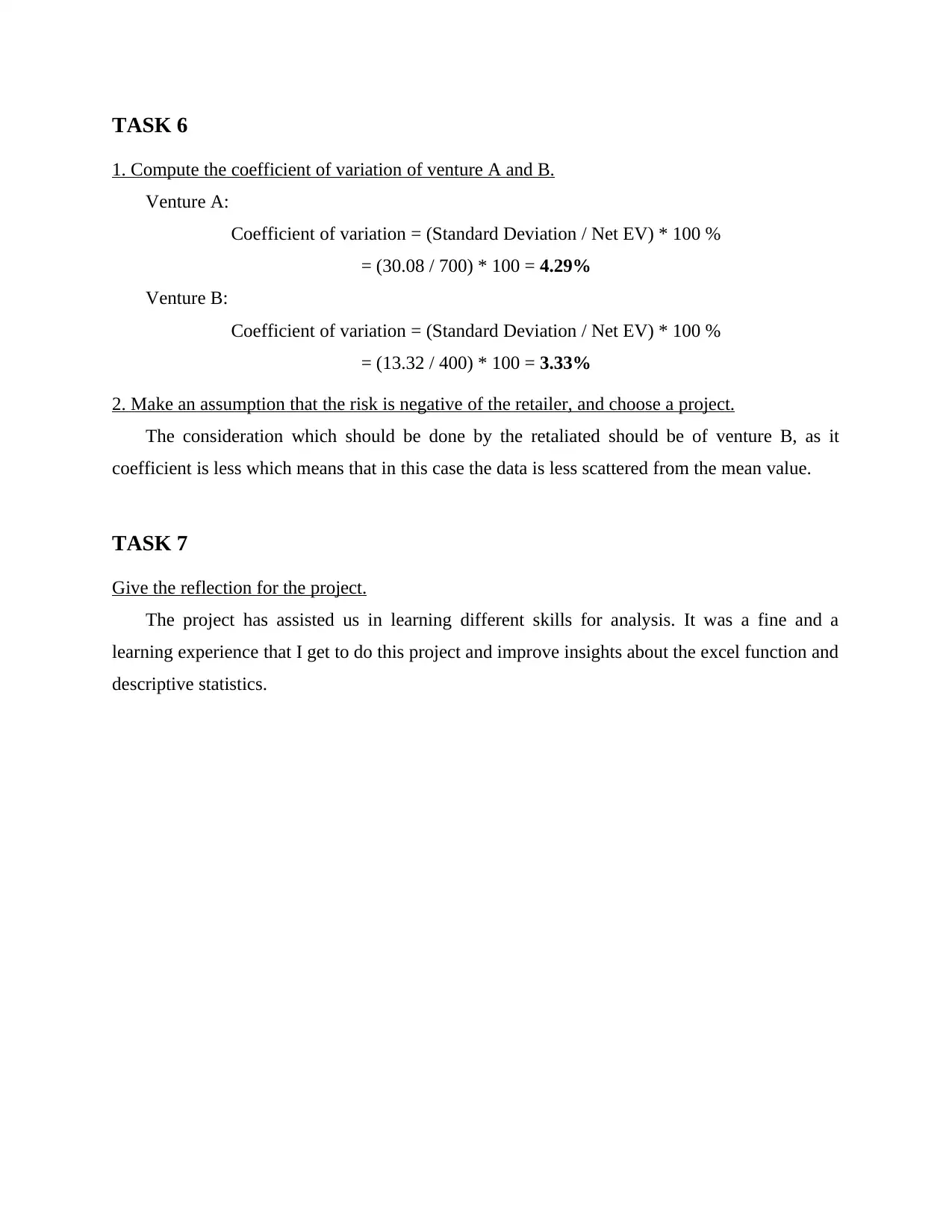
TASK 6
1. Compute the coefficient of variation of venture A and B.
Venture A:
Coefficient of variation = (Standard Deviation / Net EV) * 100 %
= (30.08 / 700) * 100 = 4.29%
Venture B:
Coefficient of variation = (Standard Deviation / Net EV) * 100 %
= (13.32 / 400) * 100 = 3.33%
2. Make an assumption that the risk is negative of the retailer, and choose a project.
The consideration which should be done by the retaliated should be of venture B, as it
coefficient is less which means that in this case the data is less scattered from the mean value.
TASK 7
Give the reflection for the project.
The project has assisted us in learning different skills for analysis. It was a fine and a
learning experience that I get to do this project and improve insights about the excel function and
descriptive statistics.
1. Compute the coefficient of variation of venture A and B.
Venture A:
Coefficient of variation = (Standard Deviation / Net EV) * 100 %
= (30.08 / 700) * 100 = 4.29%
Venture B:
Coefficient of variation = (Standard Deviation / Net EV) * 100 %
= (13.32 / 400) * 100 = 3.33%
2. Make an assumption that the risk is negative of the retailer, and choose a project.
The consideration which should be done by the retaliated should be of venture B, as it
coefficient is less which means that in this case the data is less scattered from the mean value.
TASK 7
Give the reflection for the project.
The project has assisted us in learning different skills for analysis. It was a fine and a
learning experience that I get to do this project and improve insights about the excel function and
descriptive statistics.

PART 2
a) Anticipate the variable cost with the help of high-low demand.
Variable Cost per unit = (Highest Activity Cost - Lowest Activity Cost) / (Highest
Activity Units - Lowest Activity Units)
= (4,00,000 - 1,95000) / (34,000 - 14000)
= 205000 / 20000
= 10.25
b) Compute monthly fixed cost.
Fixed Costs = Highest Activity Cost - (Variable Cost Per Unit * Highest Activity Units)
= 4,00,000 - (10.25 * 34,000) = 51500
c) Compute break-even of January.
Units sold in January to reach break-even = Fixed cost / (Selling price – Variable cost)
= 51500 / (12.72– 10.25) = 20850
d) Number of T-shirt that should be sold in order to achieve target.
Current Sales level for achieving target = (Estimated Profit + Fixed Costs) / (Selling price
per Unit- Variable cost per unit)
= (60000 + 56200) / (12.72– 10.25) = 116200 / 2.9 = 47044.53 units
e) Compute margin of safety.
Margin of safety = (Current Sales Level – break-even point) / Current Sales level
= (47045 – 20850) / 47045 = (26195 / 47045) * 100 = 55.68%
f) Pros and cons of break-even analysis.
Pros Cons
Formula friendly No semi variable costs
Changes can be compared easily Relied on the accuracy and quality of
information (Lara-Cerrillo and et.al., 2021)
Strategic decision making tool It is assumed that the revenue and cost are
a) Anticipate the variable cost with the help of high-low demand.
Variable Cost per unit = (Highest Activity Cost - Lowest Activity Cost) / (Highest
Activity Units - Lowest Activity Units)
= (4,00,000 - 1,95000) / (34,000 - 14000)
= 205000 / 20000
= 10.25
b) Compute monthly fixed cost.
Fixed Costs = Highest Activity Cost - (Variable Cost Per Unit * Highest Activity Units)
= 4,00,000 - (10.25 * 34,000) = 51500
c) Compute break-even of January.
Units sold in January to reach break-even = Fixed cost / (Selling price – Variable cost)
= 51500 / (12.72– 10.25) = 20850
d) Number of T-shirt that should be sold in order to achieve target.
Current Sales level for achieving target = (Estimated Profit + Fixed Costs) / (Selling price
per Unit- Variable cost per unit)
= (60000 + 56200) / (12.72– 10.25) = 116200 / 2.9 = 47044.53 units
e) Compute margin of safety.
Margin of safety = (Current Sales Level – break-even point) / Current Sales level
= (47045 – 20850) / 47045 = (26195 / 47045) * 100 = 55.68%
f) Pros and cons of break-even analysis.
Pros Cons
Formula friendly No semi variable costs
Changes can be compared easily Relied on the accuracy and quality of
information (Lara-Cerrillo and et.al., 2021)
Strategic decision making tool It is assumed that the revenue and cost are
⊘ This is a preview!⊘
Do you want full access?
Subscribe today to unlock all pages.

Trusted by 1+ million students worldwide

linear functions.
Paraphrase This Document
Need a fresh take? Get an instant paraphrase of this document with our AI Paraphraser
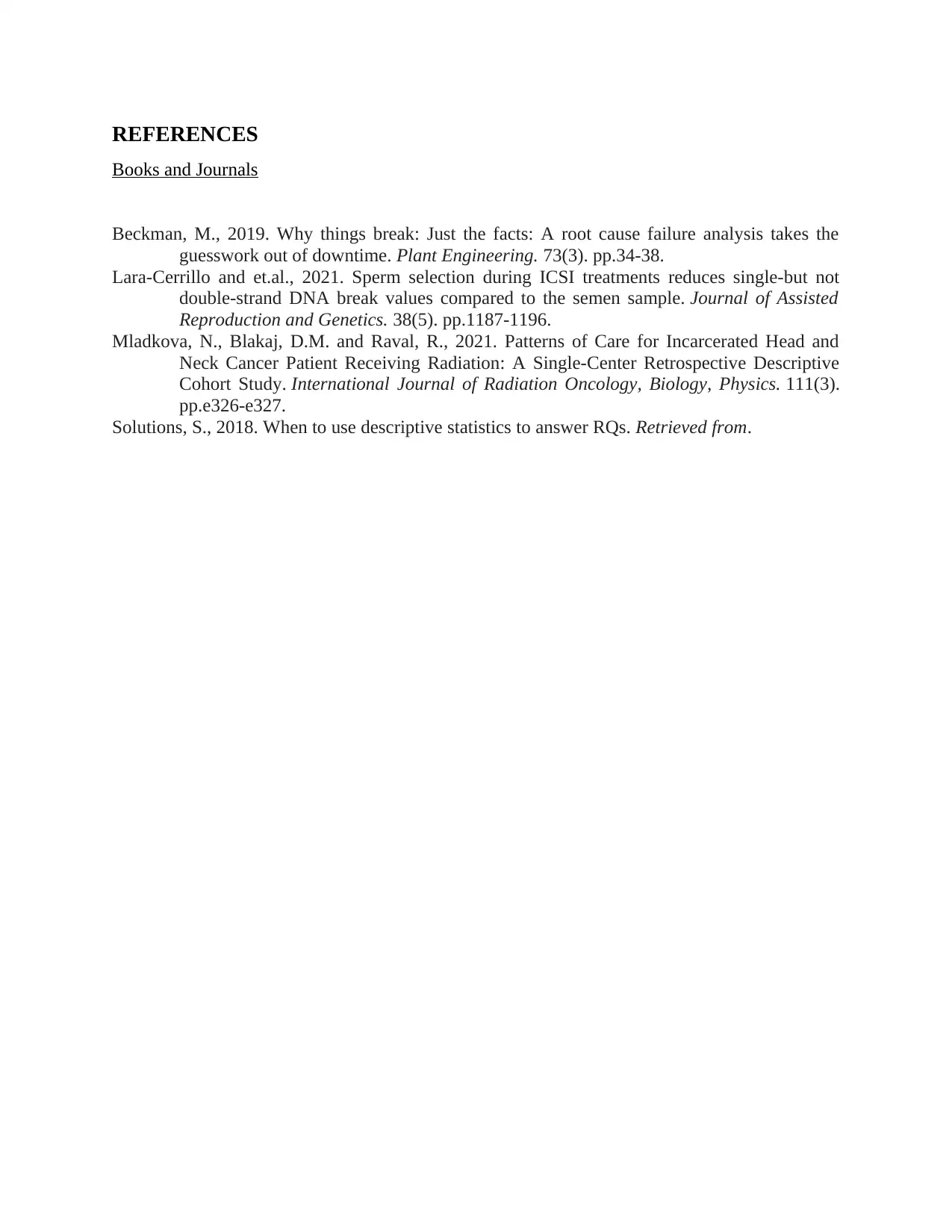
REFERENCES
Books and Journals
Beckman, M., 2019. Why things break: Just the facts: A root cause failure analysis takes the
guesswork out of downtime. Plant Engineering. 73(3). pp.34-38.
Lara-Cerrillo and et.al., 2021. Sperm selection during ICSI treatments reduces single-but not
double-strand DNA break values compared to the semen sample. Journal of Assisted
Reproduction and Genetics. 38(5). pp.1187-1196.
Mladkova, N., Blakaj, D.M. and Raval, R., 2021. Patterns of Care for Incarcerated Head and
Neck Cancer Patient Receiving Radiation: A Single-Center Retrospective Descriptive
Cohort Study. International Journal of Radiation Oncology, Biology, Physics. 111(3).
pp.e326-e327.
Solutions, S., 2018. When to use descriptive statistics to answer RQs. Retrieved from.
Books and Journals
Beckman, M., 2019. Why things break: Just the facts: A root cause failure analysis takes the
guesswork out of downtime. Plant Engineering. 73(3). pp.34-38.
Lara-Cerrillo and et.al., 2021. Sperm selection during ICSI treatments reduces single-but not
double-strand DNA break values compared to the semen sample. Journal of Assisted
Reproduction and Genetics. 38(5). pp.1187-1196.
Mladkova, N., Blakaj, D.M. and Raval, R., 2021. Patterns of Care for Incarcerated Head and
Neck Cancer Patient Receiving Radiation: A Single-Center Retrospective Descriptive
Cohort Study. International Journal of Radiation Oncology, Biology, Physics. 111(3).
pp.e326-e327.
Solutions, S., 2018. When to use descriptive statistics to answer RQs. Retrieved from.
1 out of 14